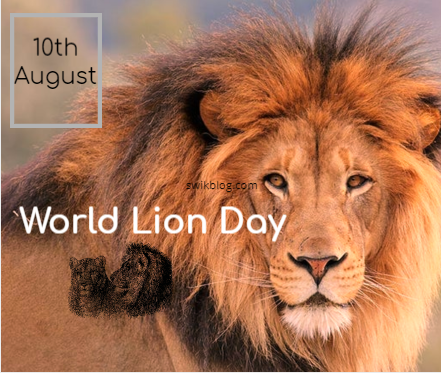World Lion Day 10th August 2022

Every year 10th August is celebrated as World Lion Day to celebrate lions globally. The day is celebrated to bring awareness about the declining population of lions in the world. The Co-founder of the Big Cat Initiative and the National Geographic, Dereck and Beverly Joubert started a partnership for the Lion Day in 2013. The project is also considered to preserve these wild cats in their natural habitat under the banner of the National Geographic Big Cats initiative. In fact, the program will collaborate with people residing with wild cats on safety steps.
Lions moved across Africa and the Eurasian supercontinent three million years ago. Today, however, separate ice ages and natural climate changes mean that their range is largely limited to Africa and small parts of Asia.
As defined by the International Union for the Conservation of Nature Lions are a “vulnerable” species, which means their numbers should be higher. Researchers are currently estimating that the presence of lion on Earth is between 30,000 and 100,000. There is a possibility that they will be on the endangered list, like other animals most at risk of extinction, without any meaningful action.
The lion species is one of the world’s largest species and which are also known as Panthera leo. They can vary from light buff to a deep reddish-brown color with a typically 300 to 550 pounds of weight. The uncommon white lion, which is only in the wild, is also surprising. The lion has a louder, deafening roar, and is quickly identified by its thick head. Unfortunately, they are gradually vanishing, as majestic lions seem to me.
World Lion Day is a day for the lion lovers around the world which also gives an opportunity to fight the extinction of the king of beasts’ territory and habitats. Such giant mammals are one of the largest creatures in the world and one of the most reputed top predators. If species disappear completely from the natural environment, it would be a tragic loss for both nature and humanity.
Facts about Lions
- Lions are important predators, who contribute to the development of feeding opportunities for a wide number of other species, and they also help manage grazing populations.
- There are about 20,000 to 30,000 lions are left in the world.
- Mostly all wild lions live in Africa, below the Sahara Desert, but in western India, there is one small population around Gir Forest National Park. Such Asian lions in India, or those found in Southeast and South Africa, are more closely related in West and Central Africa.
- Lions originally evolved in Africa 1 million years ago. The modern Lion first appeared in East and Southern Africa 100,000 years ago.
- Lions are typically tawny, but there are small, wild, rarely-colored sub-populations. There is a population noted for leucism in South Africa, which results in very light blond fur; and a melanistic population of dark brown, almost black fur is found in Iran.
- Lions are adaptive to very dry areas they can live in dry areas like the Kalahari Desert where they get most of the water from their prey and even from plats like Tsamma melon.
- Lions hunt down big animals like zebra and wildebeest.
- With one meal, lions can consume up to 40 kg of meat-around a quarter of their body weight. Their tongues, called papillae, have sharp-pointed rasps that are used to scrape meat off bones.
- A roar of adult lion can be heard at a distance of 5 miles.
While a population of 20,000 30,000 may sound like a lot, it spells danger to the lion in the grand scheme of things. Their numbers have declined by about 30 percent in the last 20 years and today more than 40 percent of their population is declining. Until 2015, the lions were not placed under the protection Endangered Species Act and this could explain why the numbers of lions are declining.
Swikriti Dandotia



